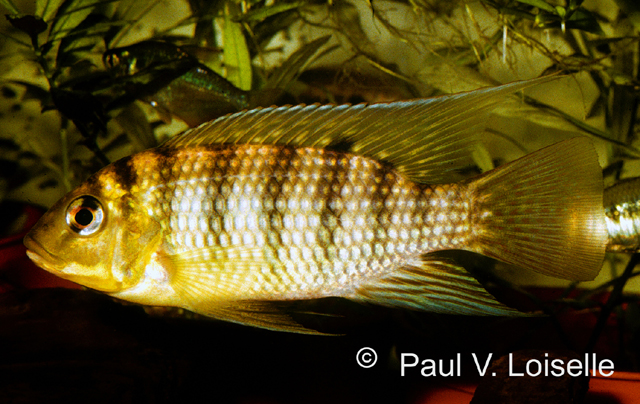| Cichlidae (Cichlids), subfamily: Pseudocrenilabrinae |
| 24.8 cm SL (male/unsexed) |
|
demersal; freshwater |
| Africa: middle and lower courses of coastal rivers from Guinea-Bissau (Geba and Corubal Rivers) to Liberia (Cess River)(Ref. 53405). Possibly also present in Côte d'Ivoire (Ref. 272). |
|
Dorsal spines (total): 15-17; Dorsal soft rays (total): 11-14; Anal spines: 3-3; Anal soft rays: 8-10. Diagnosis: body oblong (body depth 32.0-46.1% SL); outer teeth on jaws bicuspid and spatulated; micro-gillrakers present; transversal bands on the flanks (Ref. 53405).
Description: body relatively slender; frontal profile steep, in large specimens sometimes slightly concave (Ref. 52307). Lower pharyngeal bone as long as broad, length of toothed part 50.0-67.1% of total bone length; inner jaw teeth tricuspid, posterior pharyngeal teeth bicuspid and not broadened; scales cycloid (Ref. 53405).
Coloration: preserved specimens: yellowish-grey, with 8-9 dark cross bars on back and sides; upper side of head dark brown; dark preorbital band running from eye to corner of mouth; midlateral longitudinal band sometimes present; "tilapian" spot well visible; pectoral fins transparent; pelvics greyish, darker anteriorly; dorsal, anal and caudal fins greyish, but dorsal and caudal marked with light spots; distal margin of dorsal fin blackish in some specimens (Ref. 53405). Depending on situation, 2 longitudinal stripes may be present instead of vertical bars (especially when breeding), at other times a combination of these patterns is present; rarely, neither stripes nor bars present; males often with bluish stripes and dots in dorsal and anal fin; also male dorsal and upper parts of caudal fin sometimes with a thin red margin; caudal fin sometimes with reddish spots; anal and pelvic fins with a dark anterior edge (Ref. 52307). |
| Pair-bonding, open substratum spawner, with both parents guarding the brood; seems to breed throughout the year; development time of larvae, from deposition of eggs to free swimming stage, takes about 13 to 14 days (Ref. 52307). |
|
Least Concern (LC); Date assessed: 14 January 2020 Ref. (130435)
|
| harmless |
Source and more info: www.fishbase.org. For personal, classroom, and other internal use only. Not for publication.
